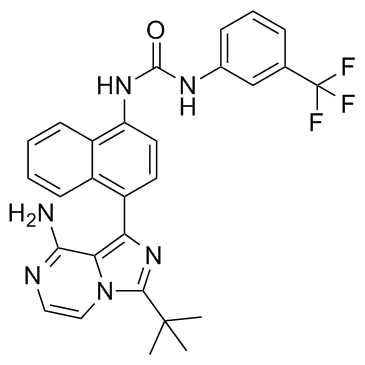| Description |
KIRA6 allosterically inhibits IRE1α RNase kinase activity with an IC50 of 0.6 µM.
|
| Related Catalog |
|
| Target |
IC50: 0.6 µM (IRE1α RNase kinase)[1]
|
| In Vitro |
KIRA6 dose-dependently inhibits IRE1α (WT) kinase activity, XBP1 RNA cleavage, Ins2 RNA cleavage and oligomerization. KIRA6 strongly inhibits JNK phosphorylation from IRE1α hyperactivation or ER stress. Also, KIRA6 dose-dependently inhibits Ins1 mRNA decay, proinsulin depletion, and apoptosis from IRE1α hyperactivation. In INS-1 cells, KIRA6 inhibits IRE1α auto-phosphorylation by Tg and XBP1 mRNA splicing by Tm in a dose-dependent manner. KIRA6 reduces ER stress-induced death of cultured cells and in pancreatic islet explants[1].
|
| In Vivo |
KIRA6 has negligible toxicity up to 10 μM, providing a favorable therapeutic index to test cytoprotection. KIRA6 in BALB/c mice intraperitoneally (i.p.) dosed at 10 mg/kg shows good drug plasma AUC levels with moderate clearance (22.4 mL/min/kg). Drug half-life is 3.90 hours, Cmax is 3.3 μM, and plasma levels at 4 and 8hr are 1.2 μM and 0.33 μM, respectively. Intravitreal co-injection of KIRA6 with Tm significantly reduces XBP1 splicing, TXNIP induction, and decay of the ER-localized photoreceptor-specific Rhodopsin mRNA. KIRA6 dose-dependently inhibits Rhodopsin RNA cleavage by IRE1α. Concomitant with blockage of Terminal UPR outputs, co-injection of KIRA6 in the Tm model reduces photoreceptor loss by Optical Coherence Tomography (OCT) and histology. KIRA6 substantially protects against loss of ERG responsiveness, significantly preserving both a- and b-wave amplitudes[1].
|
| Animal Admin |
Mice: Male Ins2+/Akita mice are injected i.p. with KIRA6 in a 2 mg/mL. Same solution without KIRA6 is denoted as Vehicle. C567BL/6 mice are also injected with same KIRA6 solution and indicated doses of Tm for liver analysis[1].
|
| References |
[1]. Ghosh R, et al. Allosteric inhibition of the IRE1α RNase preserves cell viability and function during endoplasmic reticulum stress. Cell. 2014 Jul 31;158(3):534-48.
|
